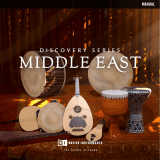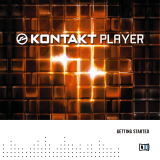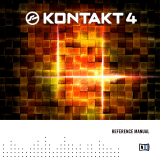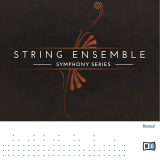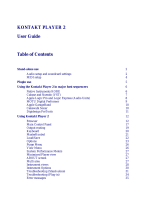Page is loading ...


The information in this document is subject to change without notice and does not represent a
commitment on the part of Native Instruments GmbH. The software described by this docu-
ment is subject to a License Agreement and may not be copied to other media. No part of this
publication may be copied, reproduced or otherwise transmitted or recorded, for any purpose,
without prior written permission by Native Instruments GmbH, hereinafter referred to as Native
Instruments.
“Native Instruments”, “NI” and associated logos are (registered) trademarks of Native Instru-
ments GmbH.
All other trademarks are the property of their respective owners and use of them does not imply
any affiliation with or endorsement by them.
Document authored by: Adam Hanley, Antriksh Bali, Nikolas Jeroma
Software version: 1.0 (01/2016)
Document version: 1.0 (01/2016)
Disclaimer

NATIVE INSTRUMENTS GmbH
Schlesische Str. 29-30
D-10997 Berlin
Germany
www.native-instruments.de
NATIVE INSTRUMENTS North America, Inc.
6725 Sunset Boulevard
5th Floor
Los Angeles, CA 90028
USA
www.native-instruments.com
NATIVE INSTRUMENTS K.K.
YO Building 3F
Jingumae 6-7-15, Shibuya-ku,
Tokyo 150-0001
Japan
www.native-instruments.co.jp
NATIVE INSTRUMENTS UK Limited
18 Phipp Street
London EC2A 4NU
UK
www.native-instruments.com
© NATIVE INSTRUMENTS GmbH, 2016. All rights reserved.
Contact

Table of Contents
1 Welcome to DISCOVERY SERIES: INDIA .......................................................................
6
1.1 What is DISCOVER SERIES: INDIA? .............................................................................................. 6
1.2 Document Conventions ............................................................................................................... 6
2 The DISCOVERY SERIES: INDIA Library ........................................................................
8
2.1 Included Instruments ................................................................................................................. 8
2.1.1 Percussion ................................................................................................................. 8
2.1.2 Melodic ...................................................................................................................... 14
3 Using the Instruments ................................................................................................
19
3.1 Shared Features ......................................................................................................................... 19
3.1.1 Navigation ................................................................................................................. 19
3.1.2 Sound Presets ............................................................................................................ 19
3.1.3 Mapping .................................................................................................................... 20
3.1.4 ModWheel .................................................................................................................. 22
3.2 Ensemble .................................................................................................................................... 23
3.3 Percussion .................................................................................................................................. 25
3.4 Patterns ...................................................................................................................................... 27
3.4.1 Pattern Selection and Playback ................................................................................. 28
3.4.2 MIDI Export ................................................................................................................ 29
3.4.3 Groove and Feel ......................................................................................................... 31
3.4.4 Browsing and Editing Patterns .................................................................................. 32
3.5 Melodic ....................................................................................................................................... 34
3.5.1 Drone ......................................................................................................................... 36
3.5.2 Scales and Mapping .................................................................................................. 37
3.6 Mixer ........................................................................................................................................... 41
3.6.1 Instrument Channels ................................................................................................. 42
Table of Contents
INDIA - Manual - 4

3.6.2 Reverb ....................................................................................................................... 44
3.6.3 Master ....................................................................................................................... 45
4 Credits ......................................................................................................................
48
Table of Contents
INDIA - Manual - 5

1 Welcome to DISCOVERY SERIES: INDIA
Thank you for purchasing DISCOVERY SERIES: INDIA. On behalf of the Native Instruments
team, we hope this new KONTAKT library truly inspires you.
DISCOVERY SERIES: INDIA adds a selection of exclusively sampled percussion and melodic
instruments that integrate into the latest versions of KONTAKT 5 or the free KONTAKT PLAY-
ER. These instruments have been carefully crafted to be both authentic and easy to use. Creat-
ing the atmosphere of an Indian musical ensemble is now as easy as it gets, even if you are not
deeply familiar with the musical style.
This manual will introduce you to the different instruments that have been sampled for this
collection, and explain how to use the KONTAKT instruments.
1.1 What is DISCOVER SERIES: INDIA?
Continuing Native Instruments' Discovery Series of sounds from around the world, DISCOVERY
SERIES: INDIA is a collection of multi-sampled instruments from the respective region. Based
on traditional techniques, this library is designed to add authentic Indian flavors to your music
productions.
1.2 Document Conventions
This document uses particular formatting to point out special facts and to warn you of poten-
tial issues. The icons introducing the following notes let you see what kind of information can
be expected:
The speech bubble icon indicates a useful tip that may often help you to solve a task
more efficiently.
The exclamation mark icon highlights important information that is essential for the giv-
en context.
Welcome to DISCOVERY SERIES: INDIA
What is DISCOVER SERIES: INDIA?
INDIA - Manual - 6

The red cross icon warns you of serious issues and potential risks that require your full
attention.
Furthermore, the following formatting is used:
▪ Text appearing in (drop-down) menus (such as Open…, Save as… etc.) in the software and
paths to locations on your hard disk or other storage devices is printed in italics.
▪ Text appearing elsewhere (labels of buttons, controls, text next to checkboxes etc.) in the
software is printed in blue. Whenever you see this formatting applied, you will find the
same text appearing somewhere on the screen.
▪ Important names and concepts are printed in bold.
▪ References to keys on your computer’s keyboard you’ll find put in square brackets (e.g.,
“Press [Shift] + [Enter]”).
►
Single instructions are introduced by this play button type arrow.
→
Results of actions are introduced by this smaller arrow.
Welcome to DISCOVERY SERIES: INDIA
Document Conventions
INDIA - Manual - 7

2 The DISCOVERY SERIES: INDIA Library
The DISCOVERY SERIES: INDIA library is split into three main sections:
Ensemble
The India Ensemble is a single KONTAKT Instrument containing a number of percussion and
melodic instruments that produce the sound of a full traditional Indian musical ensemble.
The Instrument contains patterns, single hits, and tonal notes. The entire MIDI key-range is fil-
led with sounds.
Percussion
The Percussion Instruments each contain a single Indian percussion instrument, mapped in
more detail than the India Ensemble. These instruments contain patterns, fills, and single hits.
Melodic
The Melodic Instruments each contain a single Indian melodic instrument. These instruments
can be played normally, and include a number of ornaments (like slides) as well as a built-in
Tanpura drone.
2.1 Included Instruments
2.1.1 Percussion
The following percussion instruments are included in this library:
The DISCOVERY SERIES: INDIA Library
Included Instruments
INDIA - Manual - 8

Dhol
Most popularly played from Punjab through the entire North-Indian region of India. There are
differing accounts on how and where the instrument originated: while one theory claims that
instruments similar in build and shape to the dhol have been around for several centuries, an-
other more plausible origin story attributes the introduction of the instrument to the presence
of duhul, a 15th century Persian drum that was brought to India during the rule of the Mugh-
als.
The dhol typically consists of a double sided barrel drum, with both of the skins being hit by
sticks. While different variations and constructions methods exist for the dhol, the most widely
used is the Punjabi or 'Bhangra' dhol, which has a large and heavy body for producing loud
bass. Bhangra is a common musical form that is widely played by 'Dholi' (dhol players), which
is known for its energetic rhythms and danceable grooves. One can often hear the dhol in full
form at Indian wedding ceremonies or in festival celebrations.
The DISCOVERY SERIES: INDIA Library
Included Instruments
INDIA - Manual - 9

Dholak
The dholak is a double-sided drum, usually made up of wood. One side is known to have a
thicker skin, while the other has a tightly stretched thin parchment which gives it a sharper
tone. It is usually placed horizontally on one’s lap and played with both hands and fingers. In
some special cases, a spoon is used to tap on the center of the instrument in addition to the
usage of hands.
The development and origin of the dholak is largely connected to the emergence of the dhol in
Indian folk music. Being a derivative of the dhol, it is another instrument that is used far and
wide in the North-Indian region. The dholak is typically used to provide minimal percussion in
folk and spiritual music. It is most often heard during celebrations, important occasions, and
festive days.
Ghatam
The DISCOVERY SERIES: INDIA Library
Included Instruments
INDIA - Manual - 10

Ghatam is a South Indian percussive instrument dating back to ancient times. Having originat-
ed from clay pots or 'madgas' that were originally used to store water, yogurt and cooking mate-
rials, the ghatam eventually evolved into a musical instrument. The musical ghatam is built
with thicker walls and a good tone, compared to a simple clay pot.
The ghatam is typically placed close to the player’s body with its opening near the abdomen.
The heels of the hand hit near the opening to provide bass sounds and finger-tapping is used
to provide different treble sounds from different parts of the ghatam. Ghatam almost always
accompanies and plays the same rhythm as the mridangam in an ensemble setting.
Kanjira
The kanjira is a secondary percussion instrument frequently used in Carnatic and South-Indian
music. Being a member of the frame-drum family, the instrument first came to prominence
around the late 19th century to the mid-20th century. Having been around for some time, the
instrument has undergone a few changes over the years, eventually turning into the present
form, similar to the western tambourine.
Being 8 to 10 inches in breadth and 2 to 3 inches in depth, the kanjira is small in size, which
makes it the ideal percussive instrument to accompany the larger, more bass-heavy instru-
ments like the mridangam. It consists of a drumhead made up of monitor lizard skin, and met-
al discs (jingles) that give it a shaker-like quality. Despite its size, the kanjira is known to be
one of the toughest percussion instruments to play.
The DISCOVERY SERIES: INDIA Library
Included Instruments
INDIA - Manual - 11

Khol
Originating in the north-eastern states of India, from West Bengal and Assam to Manipur, the
khol is folk percussion instrument mainly used in Northern India. The instrument is widely fa-
mous for its almost-universal use by devotees of Lord Krishna. It is traditionally used in spiritu-
al ceremonies like 'bhajans' and 'kirtans'.
The khol is a double-sided drum, similar in shape to mridangam, but with a smaller side that
is one sixth the size of the larger side, and gives the drum its characteristic treble sound. The
Khol is played in a similar fashion to the mridangam, with both hands and fingers. However,
the khol also allows the player to modulate pitch while playing.
Mridangam
The mridangam is a percussion instrument that was originally used in Carnatic music. In tamil
culture, the instrument is also known by the name 'tannumai'.
The DISCOVERY SERIES: INDIA Library
Included Instruments
INDIA - Manual - 12

The mridangam instrument is a close relative to its North Indian counterpart - the pakhawaj.
However, the sound of the mridangam drastically varies from the sound of the pakhawaj due to
differences in construction. The mridangam is mostly made of wood, except for the heads on
either side of the drum, and it is tuned using a small wooden block and a heavy stone.
The mridangam is a key component of South indian classical music and usually accompanies
vocals, veena, or violin.
Pakhawaj
Pakhawaj is a North-Indian percussion instrument that can essentially be thought of as a de-
scendant of the mridangam. It is typically played with both the right and left hand, and con-
sists of a bigger side and a smaller side.
Coming to the forefront around the 14th century, the pakhawaj has faded much more into the
background in recent times, with the tabla more or less replacing it in more recent composi-
tions. However, the vivid bass tone that the Pakhawaj produces is still a common occurrence in
spiritual gatherings and ceremonies.
The DISCOVERY SERIES: INDIA Library
Included Instruments
INDIA - Manual - 13

Tabla
Said to have evolved hundreds of years ago from its South-Indian counterpart the pakhawaj,
nothing else quite characterizes and personifies Indian classical music quite like the tabla.
This percussive instrument forms the backbone of the rhythm section in any classical Indian
music recital. However, the exact point of origin of the tabla is obscure at best.
The tabla is a percussion instrument consisting of two drums - the tabla and the bayan. The
larger drum (bayan) is used to provide bass sounds, the pitch of which can be controlled using
the heel of the hand, and the smaller drum (tabla) provides the various treble sounds.
2.1.2 Melodic
The following melodic instruments are included in this library:
Bansuri
The bansuri is a transverse flute made from a single hollow shaft of bamboo with six or seven
finger holes. The word bansuri originates from the Sanskrit bans (bamboo) + sur (melody).
The DISCOVERY SERIES: INDIA Library
Included Instruments
INDIA - Manual - 14

It is an ancient musical instrument associated with the pastoral tradition. The Bansuri is re-
vered as Lord Krishna's divine instrument; mythological accounts tell of Krishna's flute having
a spellbinding effect.
The North Indian bansuri, typically about 14 inches in length, was traditionally used as a so-
prano instrument primarily for accompaniment in lighter compositions. The bass variety (ap-
proximately 30 inches), has been indispensable in Hindustani Classical music for well over
half a century. Bansuris range in size from less than 12 inches to nearly 40 inches.
Harmonium
The Indian harmonium is a descendant of the European harmonium, modified over the deca-
des to better suit the practices of Indian music. It is played with the right hand while the left
hand operates a bellow, supplying the air for producing tones. The Indian harmonium is used
as an accompanying instrument for singers and solo tabla performances. In these cases, it
plays a single melodic line which depicts the tala and raga.
The DISCOVERY SERIES: INDIA Library
Included Instruments
INDIA - Manual - 15

Santur
The Indian santur (also spelled santoor) is a trapezoid shaped hammered dulcimer made of
walnut, with seventy two metal strings, native to Jammu and Kashmir. In ancient Sanskrit
Texts it has been referred to as shatatantri vina (100-stringed vina).
Traditionally, the santur is played while sitting, with the instrument resting on the players lap,
the broad side facing the musician. It is played with a pair of light wooden mallets called mez-
rabs.
Sitar
The DISCOVERY SERIES: INDIA Library
Included Instruments
INDIA - Manual - 16

The sitar is a fretted plucked string instrument used widely throughout the Indian subconti-
nent. It derives its distinctive timbre and resonance from sympathetic strings, a long hollow
neck, and a gourd-shaped resonance chamber. The lower strings, called the chikaari, provide a
drone, and the higher strings are played melodically. The frets of the sitar can be adjusted, al-
lowing for fine tuning of each interval.
The sitar is believed to have been derived from the veena, an ancient Indian instrument, which
was modified by a Mughal court musician to conform to the tastes of his Mughal patrons and
named after a Persian instrument called the setar (meaning 'three strings'). The sitar evolved
through the 16th and 17th centuries and arrived at its present form in the 18th century. The
instrument saw initial use in Western popular music by The Beatles and The Rolling Stones,
beginning a trend for the use of the sitar in popular music, making it one of the most recogniz-
able Indian instruments in the West.
Tanpura
The tanpura is a large, unfretted lute with 4 strings. The purpose of the tanpura is to produce a
constant, non-rhythmic drone. In fact, in modern India, an electronic tanpura or a tanpura CD
is often used to supply a steady drone during less formal occasions.
The DISCOVERY SERIES: INDIA Library
Included Instruments
INDIA - Manual - 17

The name tanpura is derived from tana, referring to a musical phrase, and pura, which means
'full' or 'complete'. It is believed to have developed alongside the sitar, sharing a number of
characteristics with the instrument.
Tumbi
The tumbi is a traditional North Indian musical instrument from Punjab. The high pitched, sin-
gle string instrument is associated with folk music of Punjab and presently very popular in
Western Bhangra music.
The instrument is made of a wooden stick mounted with a gourd shell resonator. A single met-
allic string runs the length of the instrument and is struck with the continuous flick and retrac-
tion of the fourth finger.
The DISCOVERY SERIES: INDIA Library
Included Instruments
INDIA - Manual - 18

3 Using the Instruments
Although the exact features of the included instruments differ, there are many common ele-
ments that will be found in most, if not all, of the instruments. As such the controls of the
instruments will be covered as one, with exceptions being pointed out along the way.
3.1 Shared Features
3.1.1 Navigation
All instruments contain two control pages, which are accessible from the tabs at the bottom of
the instruments interface:
▪ Instrument/Ensemble: Contains the instrument options, a key-map, and the pattern controls.
The name of this page will depend on the loaded instrument.
▪ Mixer: Contains the mixer controls and effects.
►
To open a control page, click on the respective tab.
3.1.2 Sound Presets
To the top right of all of the interfaces, you will see the Sound Presets menu.
The Sound Preset Menu
From here, you can browse through presets that affect the mix of the Instrument.
You can select a Sound Preset in one of two ways:
Using the Instruments
Shared Features
INDIA - Manual - 19

From the Menu
1. Click on the menu to view all available Sound Presets.
2. Click on a Sound Preset.
→
The Preset will be loaded and the sound of the Instrument will change.
From the Cycle Buttons
►
Click on the buttons to the left of the menu to cycle through the Sound Presets one at a
time.
3.1.3 Mapping
On the main Ensemble/Instrument page, below the Sound Presets, you will see a button with a
question mark.
►
Click on this button to open the Mapping Window.
Using the Instruments
Shared Features
INDIA - Manual - 20
/
